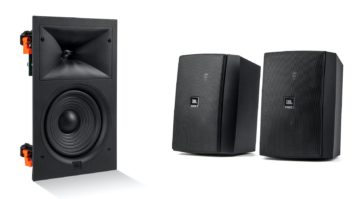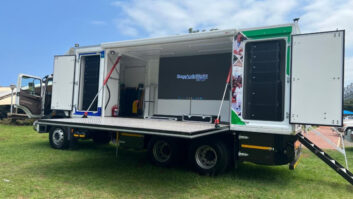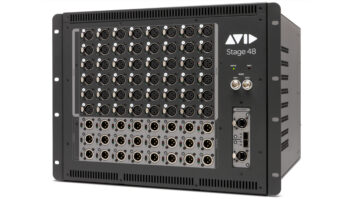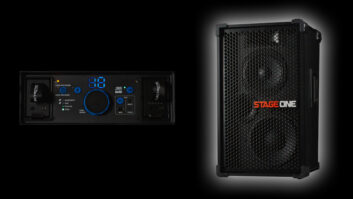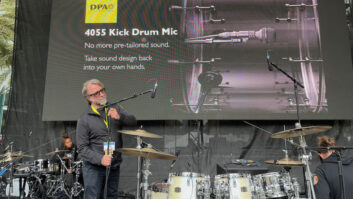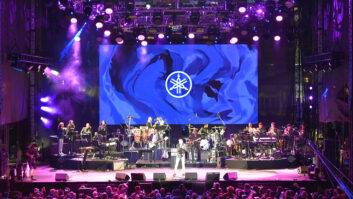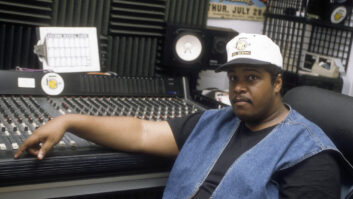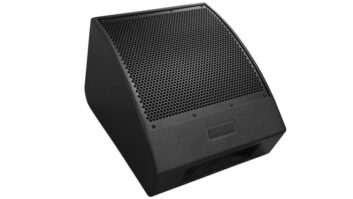Riding high on Jay-Z’s Grammy, and back-to-back Number One albums from DMX, the 1999 Hard Knock Life tour is bringing rock ‘n’ roll production to live rap-and selling out arenas across the country. Not since Run-DMC’s Fresh Fest has a rap tour been this successful. The same night ‘N Sync was playing at Portland’s Rose Garden Arena to screaming teens, it was a whole other language next door at the Memorial Coliseum. “The crowd is the show,” comments Maceo Price, who mixes DMX, as well as opening act Method Man and Redman. “This is like a backyard barbecue for 20,000 friends at 130 dB.”
Price shares a Midas XL-4 with Jay-Z’s FOH mixer, Tim Colvard. Crew chief Ted Kujawski is assisted by Jeff Sullivan, and sound services are provided by Eighth Day Audio. (Early in the tour a snowstorm stranded the trucks on the Pennsylvania Turnpike, and Eighth Day saved the day by duplicating the audio rig in the shop for the Cleveland show that night, though it ran with a generic par can light show.)
Behind the FOH mix position, DJ Clue spins house music between acts to keep the mood moving, monitoring on a pair of single-15 wedges. Price also has a pair of double-15 wedges for cueing that are delayed to the mains. “I’ve never liked headphones, because I’m trying to reproduce what’s coming out of the P.A.,” he says. “It’s more realistic to listen to it over the sound of the crowd and the room, since that’s the environment I’m mixing in. It gives me a lot more low end if I need to hear what the track and the effects are doing.” Price also points out that the bulky monitors help keep posers out of his space on the mix platform.
Both Price and Colvard use a BSS 901 dynamic equalizer, which they call “the glove,” on a vocal subgroup in order to smooth out 2.5 kHz. “It helps the lead vocal stand out of the mix without getting harsh,” Price says. “For Red and Meth, I’ve got so many backing vocals that I just put the two of them in there.” Inserted on DMX’s vocal are a Focusrite VoiceBox and a KT 3600 graphic. “With the stage level so high, I have to pull some of that wash out of his mic,” Price adds, “and then the Focusrite adds that nice wide tube feel.” Vocal effects for DMX include an H3000 S and a TC Electronic 2290 delay. “The Eventide is either a chorus or a pitch change, and the TC is set at 66 milliseconds to double the vocal in some places, or at 460 for that quick delay,” says Price.
Price uses a pair of dbx 120-XP subharmonic synthesizers on the DJ tracks, each synthesizer tuned slightly differently for “knock” at 60 to 80 Hz, and “boom” at 30 to 40. “The majority of DMX tracks have an 808 drum machine low end, and the dbx lets me add those Miami-wide sub-lows to the system without overpowering it,” explains Price. A pair of Yamaha SPX990 processors, set on Reverse Gate and Stereo Hall, add ambience to the DJ tracks. “I use them to create a synthetic ‘loud,’ because there’s parts where I have to pull the track down, but I don’t want to lose its strength,” Price explains.
MONSTROUS LOW ENDThe main speaker arrays are Turbosound Flashlights in a six-wide, four-deep configuration, with Floodlight under-hung cabinets below and a couple of three-deep Floodlight columns for side coverage. These are powered by BSS amps and use a three-zone drive rack at FOH with BSS/Turbo processors and Klark Teknik DN3600 programmable graphics. The monstrous low end demanded by the show is supplied by 48 TMS-21 subwoofers, stacked eight-wide, three high toward each side of the stage.
Carlton “Phrogg” Brown, an old MSI hand who has toured with Busta Rhymes, R. Kelly and The O’Jays, mixes monitors for all three acts on a Yamaha PM4000M, assisted by Aaron Graves. The input list comprises wireless and hard-wired Shure vocal mics and DI inputs for each DJ. A dozen channels of Shure U2 cover the wireless needs for all three acts, and the ability to change capsules quickly is helpful. “I use Beta 87s for Redman and Method Man and then switch to Beta 58s for DMX and Jay-Z,” Brown explains. “Some of the transmitters are shared, but the capsules get soggy if you don’t change them out.” He also adds that the ability to change frequencies when last-minute RF problems crop up is vital. “I don’t know if it’s walkie-talkies or cell phones, but sometimes everything’s fine at soundcheck, but just before the show we start getting hits.”
All monitors are powered by Crown MacroTechs, mostly 2400s, and Crown PIP cards are used for crossovers on the wedges. Each sidefill is a pair of Floodlights stacked on top of four 21-inch Turbosound subs at each side of the stage, and these are used mostly for DJ music. Pairs of Apogee 3×3 speakers flown above those spread the vocals around the stage.
Across the front are four pairs of Eighth Day’s proprietary single-15 floor monitors. These downstage wedges are run as a single mix and are symmetrically paired from the center-line outward so they can be delayed with a single BSS 804. Delay settings of 18.5 to 8.5 feet gradually compensate for the additional time it takes for the sidefills to synchronize with the wedges. “There’s so much in the flown sidefills that the delay is needed to bring the front line up and in your face,” Brown comments. “When I turn the delay off to compare what it’s doing, the wedges just vanish.”
Redman and Method Man’s twin DJ setups each have a double-15 wedge. “Besides five wireless running all around the stage, there are two hard-wires for the DJs with their wedges pointed right at them, so as soon as he moves his head, everything in his mix goes right into the mic,” Brown says. Putting their vocals in the sidefills keeps it safe. “Everybody says, ‘Make me louder than them,’ so I have to keep chasing it a little bit, take one up while he does his verse and then take it back down.” Another upstage position used by both DMX and Jay-Z’s DJ has a stereo pair of single-15s.
“We had to turn down the woofers in the DJ wedges so the turntables wouldn’t skip,” Brown comments. After the switch to the 360 Systems Instant Replay, the DJs were heard to say “that’s what I needed all along.”
INSTANT REPLAY IS THE WAY TO GO”It was difficult to convince them to go with the Replay because the DJs all have vinyl,” Price says. “Jay-Z was the first one to say, ‘Okay,’ so we went into the studio right after the Grammys, laid in his songs, came into rehearsal the next day, hit it, loved it and now we have five machines out with us.” Each DJ has his own machine, and, with 24-hour capacity hard drives, each holds all the songs, backing the others up in case of failure. Because Price programmed every song into them, there are few surprises the DJs can spring on him. “The sound quality beats a DAT machine, and you don’t have to worry about dropouts, it getting erased or the tape breaking, plus it’s instant start,” he continues. “I give the DAT machine one more year before word gets out that Instant Replay is the way to go.”
